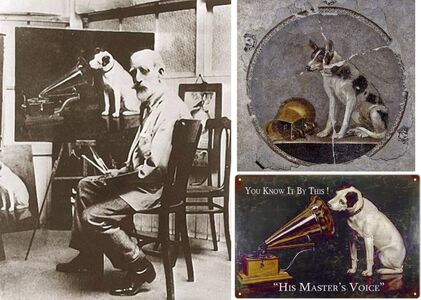Most of us are aware of the Logo of, His Master's Voice, one of the best-known commercial logos in the world. The logo is of the Gramophone Company, which has been used as a trademark by the corporations RCA Victor, EMI and JVC. His Master's Voice (HMV) was the unofficial name of a major British record label created in 1901 by The Gramophone Co. Ltd.
Some of us, particularly from the advertising industry, are aware that this is from a painting depicting a terrier-mix dog named Nipper listening to a wind-up disc gramophone.
Few of us are aware that the painting was by Francis James Barraud who was born on 16 June 1856 in Liverpool, England and died on 29 August 1924 in Kingston upon Thames. He was an English painter, the son of portrait painter Henry Barraud. After one of his works popularized the then-new field of sound recording, he became best known as a commercial illustrator. The 1898 painting His Master's Voice in its original form was completed and originally showed the dog, who had in fact died four years previously, listening to a cylinder phonograph to the voice of his master. This was a rare model, electrically driven and housed in a distinctive round-cornered case, known as the Edison-Bell Commercial Phonograph and produced by Edison's factory exclusively for the British market. Barraud later replaced the phonograph with a disc machine on the suggestion of William Barry Owen of The Gramophone Company, which then bought the picture by agreement. It was used for advertising by the Gramophone Company and by its US affiliate the Victor Talking Machine Company and soon became one of the world's most recognizable trademarks.
Fewer still are aware that Barraud’s inspiration for this painting came from a Ptolemaic mosaic from Hellenistic Egypt depicting a realistic scene of a male dog with a gilded metal askos, vessel for containing water or wine, with looped handles lying nearby. Excavated from the grounds of the New Alexandria, this Ptolemaic mosaic from Hellenistic Egypt, dated between 200 - 150 BC, is now located in the Greco-Roman Museum of Alexandria, Egypt. While it is slightly damaged at the centre with cracks and fragmentary along the sides, surrounded by a grey lion-head motif. The rich variety of coloured tesserae pieces adds depth, lighting, and shading to the scene similar to Hellenistic Greek paintings of the time period. It could represent a household owner's pet, or perhaps it implies a domestic banquet had occurred and the askos has been emptied for the occasion.
Image : Left. Francis James Barraud with his painting.
Right, Top. Ptolemaic mosaic from Hellenistic Egypt. Bottom. Logo of His Master's Voice.

